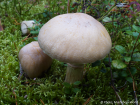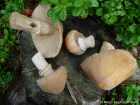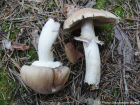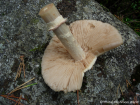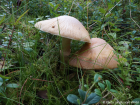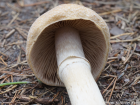Cap yellow-brown to brownish-ochre and covered with whitish fibres, especially over the centre. The surface has a wrinkled and furrowed texture. It may have a lilac tinge when young. Initially convex before expanding and flattening with a boss (umbo) in the centre. Gills pallid buff or clay, adnate, crowded. The gills are covered by a white partial veil when young. Stem slightly swollen at the base, and is whitish with a thick whitish ring at the midsection, which initially is attached to the cap. Spore print rusty brown to ochre brown.
Microscopic Features: The spores have an ellipsoidal shape, with a size of 10-15 x 7-10µm and a moderately verrucose surface.
Cortinarius caperatus on the www.first-nature.com web site.
Cortinarius caperatus on the MushroomExpert.Com web site.
Many mushrooms are poisonous, and some can be lethally toxic. Distinguishing between edible and poisonous mushrooms can be very challenging. Therefore, we strongly advise against consuming wild mushrooms. This website does not contain any information about the edibility or toxicity of mushrooms.
Although efforts have been made to ensure accuracy on this website, the information may contain errors and omissions. Therefore, all content provided is for educational and informational purposes only and should not be relied upon or used as a basis for consuming any plants or mushrooms.
External links are provided for reference only. We do not endorse or take responsibility for the content, advice, or products found on these sites or in any advertisements shown on this website.
